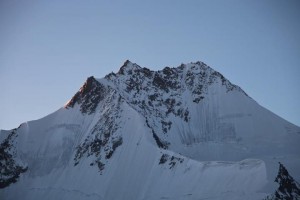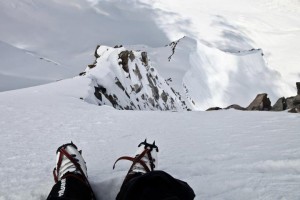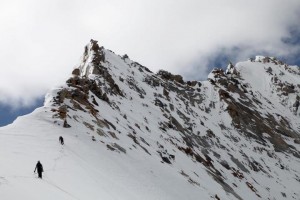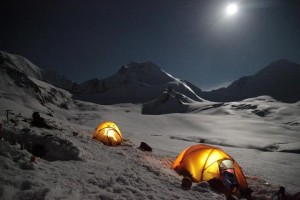Stepping gingerly onto the glacier I was relieved to hear the crunch of hard ice under my crampons rather than the boot-swallowing slush we’d battled through yesterday or the brittle crack of the thin sheets we’d traversed earlier. The beam of my head lamp swept across the white expanse, tracing the path we’d planned between the yawning crevasses. The setting moon cast eery shadows across our camp but lit up the huge wall at the base of the peak, highlighting the blue streaks of ancient ice revealed by recent avalanches. A long black stripe at the base marked the bergshund that had swallowed the falling debris and which we would have to cross to get up to ridge.
Behind me trailed a pink rope, linking me to my climbing partner. In the case that one of us broke through the surface layer into a hidden ice cavern or through a cornessed ridge into thin air, the other would have split second to anchor us both with an ice axe to avoid being yanked off his feet and into the abyss. A second team followed our steps, tied in with a green version of our life-line. The colors stood out starkly in a world of black and white and sparkled with ice crystals in the moonlight.
We threaded our way carefully across the glacier and onto the smooth ramp that lead up to the main amphitheater, cutting through the overhanging lip to clamber on top. Here the snow was softer than we’d hoped. Sinking in a few centimetres with every step, we continued on warily. The snow bridge we spotted, our only means of crossing the bergshund, was only a metre or two thick and could easily collapse if not sufficiently frozen. To get to it we needed to traverse the sloped bowl beneath the the base of the head wall that ran down into a gaping crevasse, partially covered with snow.
After a brief rest the green team lead off, taking turns to kick steps through the weak surface layer onto the harder ice below. We followed, carefully placing our feet in their steps. As the moon set into the haze it turned a pale crimson, tinging the summit ridge with red. We paused at a large, car-shaped boulder half sunk into the ice. Several more like it protruded from the face near the top. I shivered at the thought of one coming loose and tumbling down towards us. By now the green team was nearing the bergshund, a few hundred metres ahead. Suddenly my foot broke through the ice layer, sinking up to above my knee. Being heavier than the others I had gotten used to this on the approach but having seen (or more accurately perhaps, not seen) the depth of the crevasses we’d passed this morning, the weak ice layers were making me very nervous. Two more deep breaks and I called to the green team to halt. We caught them up and discussed the situation.
Its monsoon season in India and we had only just out-raced torrential rains on our journey up from central India, escaping into the mountains that bar its passage north. We had received word of flooding on the Rohtang Pass just days after we had made the crossing. It had been an unusually warm year in the Himalaya with several Everest trips cancelled due to dangerous ice conditions and at the beginning of the year two ski resorts had called in their warm weather insurance for the first time, as day time temperatures reached record highs and delayed opening by over a month. Huge ice falls had killed two parties climbing near K2 and the Keylong pass, which receives over 40feet of snow each year had been open nearly a month ahead of the usual date. The locals we spoke to described how the glaciers in the region had retreated (some by several hundred metres) in the last decade and even here, at 6000m above sea level, in a remote valley in the Himachal Pradesh, we were having trouble with unseasonably warm temperatures, with several of the party getting badly sunburned in the last few days.
Glowing noses were not the only result of the hot weather we’d had in the days leading up to our summit push. These south west facing slopes took the full brunt of the sun in the afternoons and the mild night time temperatures were too low to refreeze them completely. I shuddered to think what they’d be like by the time we returned from the top. The attempt we’d made on east ridge had taken us well into the afternoon and the waist deep snowed we’d had to plough through on the way back had been utterly exhausting. Here it would almost certainly mean breaking through the ice into who-knows-what. And the glacier would be impassable. We were confident that we could make the summit with this route, the top section of mixed rock and ice which had blocked our way last time looked far more manageable from this side. But would we make it back?
To be the first to set foot on that summit. To see the world from a brand new view point. That had been the goal of months of training and preparation and nearly four weeks of trekking, climbing and hauling gear and now four hours of slog across a glacier and up to this point. In sight of the top. We turned around. Bitterly disappointed but knowing it wasn’t worth the risk. Rescue out here is not an option, its too high for helicopters and too far from anywhere. A dropped glove or a turned ankle can be a death sentence out here, and with the risk of an avalanche or serious fall rising by the hour, we had no other option. Turning our backs on the peak we began the long slog back to camp, its shadow just beginning to materialize around us as the first light crept up from the east.
Without warning my left foot broke through the step as I weighted it and this time didn’t stop at the knee. Pitching forward the ground caved away below me and out of instinct I swung my axe into the ice, arresting myself with just my head showing. I kicked out with my legs…into nothing. Seeing me drop, my partner grabbed the rope and poised to anchor should I go further. Slowly I pulled up on the axe, clawing with one hand in the snow. Just then the lip collapsed and I desperately shunted the blade further, getting purchase on a harder section of ice. Glancing down I watched the chunk of ice disappear into the darkness below me. Pulling up over the edge I crept carefully away from the hole, up the slope to harder ice. Clearly the crevasse extended further than we had thought. Shaken but unhurt I called to the green team to head further up the slope. Then we followed, nerves on edge, ready for another break. Conscious that we had made the right decision, by noon this would be a death trap.
We crossed the creaking glacier without incident and back at camp relayed the story to those who had remained. Within hours we had packed up camp and begun the long trek back to base camp. Our rations were almost gone and it would take days of cold weather to make our route safe enough to attempt. Our time was up. The weather had spoken. Not the blizzards, white-outs or frost bite most people associate with the term “weather” in the Himalayas. The slow upward drift of average temperatures of which this is just a blip, and that may one day reduce this black and white world to a desert, its water source removed and its elegant peaks stripped of their winter wrappings. But before that happens we’ll be back. Next time with more sunscreen.




Brendan Argent
The sunburn was a combination of there being less atmosphere protecting you at 6000m than at sea level, the reflection off the snow (tending to target places you wouldn’t think to put suncscreen like the underside of your nose and under your chin) and the remarkable number of clear days we had.
My assertions that the warmer-than-usual weather was a result of climate change is perhaps a little unsubstantiated, but research by HighNoon and other organisations suggests that it probably is.
cbrodrick
It comes across in the article as if the sunburn incurred by members of the party is attributed to the unseasonably warm weather. How is this the case? Is there a know ‘hole’ in the ozone layer above the region in question, reducing the filtering efficacy of UV rays? Is it related to there being less-cloudy-than-normal weather? Does the less-compacted-than-normal ice have a higher albedo than more-compacted ice, thus reflecting more UV radiation?
peter j
Whoa! He makes it seem like a (scary, yet not cold enough) walk in the park! Well written and what an adventure young man! Well done!